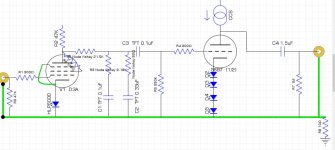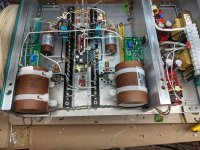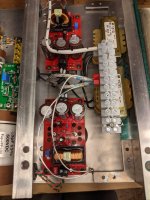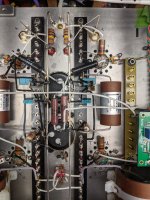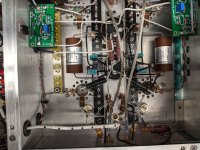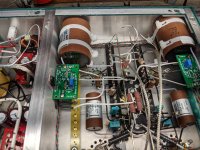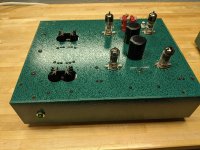I built a phono-stage as shown in the schematic. This was the second one I built after loving the first one I built. Completely silent and then after about 2 months and a hundred hours or so of play, a hiss developed in the left channel. It sounded like "tube rush" but swapping out the tubes did not change the hiss. There occasionally is a little "rustle" along with the hiss but the sound is mostly smooth. It is not audible during playback but it is there between songs.
1) swapped the tubes side to side - no change - hiss on the left still.
2) switched to another preamp input - all quiet
3) swapped leads from phono to preamp R to L - hiss follows the output of the left channel
4) swapped leads from SUT to phono R to L - hiss remains on left
5) shorted phono inputs - hiss still on left channel
6) switched mono/stereo switch to mono - hiss now in both channels but softer
7) tubes replaced - no change as expected
I reflowed all the solder joints without improvement. Did some jumping and finally seemed to narrow it down to the 330KΩ grid leak resistor before the second tube. I replaced both that resistor as well as the 300Ω carbon composite grid stopper and all was well until June - so about 6 months. I am about to dig back in but was hoping for some suggestions as to where to look?
The hiss is not always there and seems to appear more often when I've been listening awhile - meaning hours and fully warmed up.
I'd like to focus on troubleshooting rather than the merits of the design if possible.
Additionally, microphony seems to increase when the problem is occurring.
I feel I’ve exhausted the troubleshooting from the forum where I originally got the schematic and build help.
The tubes are heated with Pete Millett's DC filament supply. Each channel has its own supply.
Thanks in advance.


1) swapped the tubes side to side - no change - hiss on the left still.
2) switched to another preamp input - all quiet
3) swapped leads from phono to preamp R to L - hiss follows the output of the left channel
4) swapped leads from SUT to phono R to L - hiss remains on left
5) shorted phono inputs - hiss still on left channel
6) switched mono/stereo switch to mono - hiss now in both channels but softer
7) tubes replaced - no change as expected
I reflowed all the solder joints without improvement. Did some jumping and finally seemed to narrow it down to the 330KΩ grid leak resistor before the second tube. I replaced both that resistor as well as the 300Ω carbon composite grid stopper and all was well until June - so about 6 months. I am about to dig back in but was hoping for some suggestions as to where to look?
The hiss is not always there and seems to appear more often when I've been listening awhile - meaning hours and fully warmed up.
I'd like to focus on troubleshooting rather than the merits of the design if possible.
Additionally, microphony seems to increase when the problem is occurring.
I feel I’ve exhausted the troubleshooting from the forum where I originally got the schematic and build help.
The tubes are heated with Pete Millett's DC filament supply. Each channel has its own supply.
Thanks in advance.
When the hiss came back, was it still in the L channel?
Did you try to replace the carbon comp with something with less noise?
Jan
Did you try to replace the carbon comp with something with less noise?
Jan
Yes, exactly the same hiss apparently. I replace like with like on the grid stoppers. Rinken 300 ohm for all 4 tubes. I was told that CC was the appropriate resistor for that spot.
It may sound far fetched, but i have gone through lots of head scratching looking for hiss, just to find the culprit being a tube socket.
Are you using all newly purchased parts? Corrosion can cause noise.
Jumper R5 to determine whether the noise source is before or after that point.
In the schematic, C4 goes to the plate, not to the grid.
Jumper R5 to determine whether the noise source is before or after that point.
In the schematic, C4 goes to the plate, not to the grid.
These are brand new Belton sockets. Very snug around the pins.It may sound far fetched, but i have gone through lots of head scratching looking for hiss, just to find the culprit being a tube socket.
Is the noise still from prior to the second tube? If not, the CCS could be a problem, oscillating, etc.
Might be worth it to sub a resistor for the CCS to verify whether the noise is still there or not.
Might be worth it to sub a resistor for the CCS to verify whether the noise is still there or not.
Last edited:
I've tinnitus and such noises can "occur" without electronics ;^(
Try to clean first tube socket.
I usually use dead tube: pins dipped in to 96% isopropyl alcohol, then put to socket, pull out ... repeat it few ten times.
After it dries with hair drier.
If you have DeOxit, finish with it.
BTW any rectifier tube can damage if the first capacitor is 100uF!!
I usually use dead tube: pins dipped in to 96% isopropyl alcohol, then put to socket, pull out ... repeat it few ten times.
After it dries with hair drier.
If you have DeOxit, finish with it.
BTW any rectifier tube can damage if the first capacitor is 100uF!!
I've not dug back into the unit yet - I wanted to get some suggestions before tackling the unit. The CCSs are Bartola's. He did the surface mounting of the lower FET so the problem is likely in my work, not his.Is the noise still from prior to the second tube? If not, the CCS could be a problem, oscillating, etc.
Might be worth it to sub a resistor for the CCS to verify whether the noise is still there or not.
I'll give that a try but they are new Belton sockets as of 6 months ago so I'm pretty sure they are not the source of the hiss.Try to clean first tube socket.
I usually use dead tube: pins dipped in to 96% isopropyl alcohol, then put to socket, pull out ... repeat it few ten times.
After it dries with hair drier.
If you have DeOxit, finish with it.
BTW any rectifier tube can damage if the first capacitor is 100uF!!
I was aware of the cap/rectifier issue. However, the schematic designer assured me that the tube could handle that cap with the low current draw. The first unit I built with that same combo has worked flawlessly for over 6 years!
Last edited:
Did some jumping and finally seemed to narrow it down to the 330KΩ grid leak resistor before the second tube. I replaced both that resistor as well as the 300Ω carbon composite grid stopper and all was well until June - so about 6 months.
Is the grid leak resistor also carbon composition? Is either of them mounted at a place that gets hot?
Also try switching filament rectifiers between left and right and then ccs. Is there a specific reason why you are using such huge capacitors in the signal path?
A totally random thought and I'm a total not-know-it but . . . . . . . I have noticed some circuits change parameters as they warm up. Some change over longer periods than others. I have also noticed that microphonics can be exacerbated by oscillation. I have also noticed that subtle rustling noises can be associated with rf , oscillation or a resistor that's early in the process of breaking down, or for that matter a transistor that is. I'm wondering about that word . . . . metastability.
There you have it , absolutely nothing.
There you have it , absolutely nothing.
Yes about 55VDCIs tube's filament elevated to 1/3 .. 1/4 of B+?
No, grid leak is new TDK MF. Nothing is anywhere near a heat source and there is plenty of ventilation. The only real heat sources are the heatsinks for the filament supplies and they are mounted in a separate compartment with the sinks coming through the top plate.Is the grid leak resistor also carbon composition? Is either of them mounted at a place that gets hot?
I'll try that. The heater wiring is VERY tightly placed. Are CCSs prone to causing hiss? I am using the called out cap sizes. I'm not a designer I'm afraid.Also try switching filament rectifiers between left and right and then ccs. Is there a specific reason why you are using such huge capacitors in the signal path?
Attachments
- Home
- Amplifiers
- Tubes / Valves
- Phono-Stage Hiss
